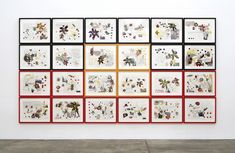Yinka Shonibare
Yinka Shonibare CBE RA was born in London/UK in 1962. From 1965 until the age of 17, he grew up in Lagos, Nigeria. In 1979 he returned to London as a teenager and completed his schooling with Advanced Level. He studied painting at the Byam Shaw School of Art (now Central Saint Martins College of Art and Design) from 1984 to 1989. From 1989 to 1991 he completed studies at Goldsmiths, University of London, where he obtained a Master's degree.
In 2009, Goldsmiths, University of London awarded him as a Fellow. In 2004, Tate London awarded him the prestigious Turner Prize. In 2005 he was appointed Member of the most excellent Order of the British Empire (MBE) and in 2019 Commander of the most excellent Order of the British Empire (CBE). The artist has been a member of the Royal Academy since 2013. Yinka Shonibare lives and works in London.
Since 1997 numerous participations in group exhibitions; solo exhibitions (selection) including Victoria and Albert Museum, London, UK (2000); Tate Britain, London, UK (2002); Moderna Museet Stockholm, SE, (2004); Boijmans Van Beuningen,Rotterdam, NL (2004); National Museum of African Art Smithsonian Institution, Washington, D.C., USA (2009); Brooklyn Museum, New York City, USA, (2009); Museum of Contemporary Art Sydney, AUS, (2009); Daegu Art Museum, Daegu, Korea (2015); in 2021, Museum Moderner Kunst Salzburg dedicated a large-scale solo exhibition to the artist titled End of Empire.
Shonibare is one of the most internationally important British artists today. His family history is rooted in Nigeria and interwoven with the era of British colonial power. In 1960, just two years before his birth, Nigeria achieved national freedom and independence. Because of his bi-cultural imprint, Shonibare describes himself as a postcolonial hybrid. Conditions of the construction of national and cultural identities are central themes in his art. A neurological disease he has suffered from since the age of 18 resulted in a hemiplegia that forces him to use a wheelchair. It provides another reason for an existence he characterizes himself as outsider within. His African heritage and his physical fate establish a personal consternation and multidimensional vulnerability. They are the reason for the artist to critically address his own experiences with racism, xenophobia and migration, the history of Europe and Africa, their political and social entanglements in colonialism and postcolonialism in our present time of globalism. He also appears in public through his active and firm commitment to the universal recognition of the rights of disabled people and his demand to recognize their artistic production as the last avant-garde.
The artist pursues a multifaceted artistic practice. He produces drawings and graphic works himself. For the use of the expressive means of photography, film and for large projects, including sculptural individual works and large-scale installations, he collaborates with teams that he instructs.
As an art student, Shonibare was encouraged to reflect artistically on his African heritage. This led him to fundamentally question cultural authenticity. As a result, the use of brightly patterned wax-print fabrics became his trademark. The artist discovered in the 1990s that these colorfully patterned fabrics, which at first glance are supposedly typically "African" and evoke notions of authenticity and exoticism, are based on the technique known as "Dutch wax." This is a wax printing process that originated in Indonesia. The fabrics were produced in factories in the Netherlands and Manchester and exported to West Africa from the 19th century. It was not until the national independence of African states that these fabrics became emancipatory and proud symbols of cultural difference.
In his works, Yinka Shonibares deals with the legacy of the fallen British Empire. The artist links historical figures and events across time with cultural and economic symbols. Playfully, he often reveals power relations only at second glance. He references recognized artists of Western art history, such as Cindy Sherman and Carolee Schneemann and William Hogarth, who in his paintings and graphic works created socially critical moral images of 18th century society, whose morals he denounced relentlessly and with biting irony.
With a keen sense of fashionable style and a taste for the Victorian era, Shonibare comparably exposed the dissolute lifestyle and affected behavior of 'white' aristocratic society. The artist stages the ambiguous morality of the fine people in drastic life-size figures as headless actors and in multi-part groups of figures, in photography and film. In their posture, body language and gestures, he illustrates excesses of decadence and violence as "transgressive behavior," which he links to historical attributes and symbols of today's consumer society as references to a lifestyle made possible by slavery and colonial exploitation. The artist presents us with mores and role-playing games in which he switches sides and, with wit and irony, sometimes becomes the protagonist himself for a mirror image he holds up to Western society. Identity-forming personalities such as Lord Nelson are dethroned and emerge in fictional history pictures of ironic ambiguity; cannonballs become colorful softballs. To commemorate the peace negotiations after World War I, Shonibare places protagonists of the negotiating parties on a seesaw with globes as heads, on which the geopolitical dimension of the conflict is mapped, and figuratively throws their territorial claims into the scales of balance.
In many ways, Shonibare is able to put into perspective our traditional view of history, which is committed to progressive thinking, has long believed in a single linear development, and has left unquestioned the dominance of the global North and Western European society. (Doris Leutgeb)
